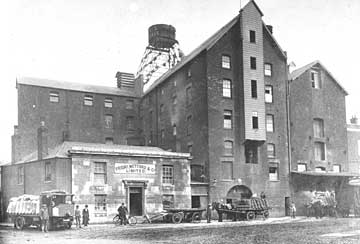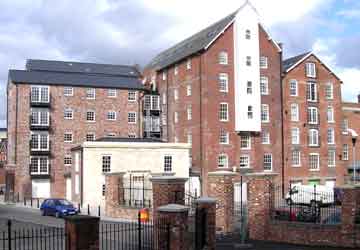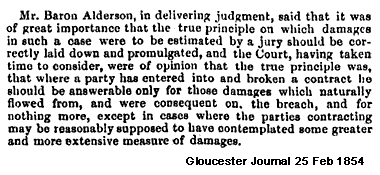Gloucester Docks & |
|
City Flour Mills/Priday's Mill |
|
|
|
The City Flour Mills in the 1920s when operated by Priday Metford & Co. The original mill is on the right and the large central building was a warehouse The water tank on the roof supplied a sprinkler system in case of fire. |
Priday's Mill in 2004 converted to apartments, with a newly built block to the left behind the rebuilt replica of the original stone-fronted office building. |
The Hadley
Brothers Hadley v Baxendale
No record has been found of any subsequent retrial before a jury, and it is assumed that the two parties settled out of court. What is certain is that the judge's ruling established the forseeability test for consequential damages that has been followed in virtually every Anglo-American jurisdiction. Hadley v Baxendale is studied in nearly all courses on contract law, it is discussed in academic papers by legal scholars and it is referred to in over 30,000 sites on the internet. However, very few lawyers know anything of its geographical setting, and so to mark the 150th anniversary of the ruling, a conference was held in Gloucester in June 2004 to discuss the international influence of the English common law in general and the current relevance of this case in particular. Top Reynolds & Allen Reynolds and Allen passed over management of the mill in 1875 to a new partnership formed by their sons, Vincent Reynolds and John Allen, together with Francis Tring Pearce who had married John Allen's sister. They were soon faced with the need for major new investment to meet the threat of growing competition from cheaper foreign flour. A totally new method of milling using rollers instead of the traditional stones had been developed in Hungary, and the partners were obliged to purchase the new equipment or risk getting left behind. Unfortunately, this investment was followed by a period of general economic difficulty, and the partners were forced to pass over the business to new management. Top Priday Metford & Co By the early years of the 20th century, most of the wheat used by the mill arrived at Gloucester in barges that loaded from sea-going ships at Sharpness or Avonmouth and delivered to the north end of the Victoria Dock. The wheat was generally loose in the barge, and then it had to be shoveled laboriously into sacks so it could be carried the few yards from the quayside to the mill on a horse-drawn wagon. In the 1920s, this procedure was swept away by the installation of a suction plant and overhead conveyor that could transfer the wheat in bulk direct to the mill silos. From c1920, Priday Metford made use of the North Warehouse for packing and storing flour, and they also had a small mill there to produce their well-known Hercules brand of wheat meal flour. In 1962, they had to move out as there was a proposal to demolish the building, and flour packing was transferred to the Victoria Warehouse with the flour being conveyed there by a pneumatic pipeline. Other modernisation at this time included the construction of a huge concrete wheat silo in 1964. During the 1970s, Liverpool became the dominant west-coast port for wheat imports, and the delivery of wheat to the mill gradually changed over from the use of barges to lorries coming down the motorway. In later years, a greater proportion of English wheat was used, and deliveries came direct from local farms. Investment during the 1980s kept the mill machinery up-to-date, and the firm supplied bakeries over a large area of the West Midlands, but further changes were needed as a consequence of the general redevelopment of the docks. In particular, the bagging plant had to be moved about half-a-mile away to release the Victoria Warehouse for conversion to offices. By this time, there was no member of the Priday, Metford or Pearce families involved with the day-to-day management of the business, and they accepted a management buy-out. Then in August 1993, the new company was taken over by the Spillers Milling subsidiary of Dalgety plc, and they ordered the closure of the mill in March 1994 because of surplus capacity. This regrettably broke the last link with the corn trade that was once so important in the docks and brought a sad end to the history of one of Gloucester's oldest companies. Sources: TNA RAIL 829 & 864 minute books; Glos Arch JV 13.1 & NV 15.3; GJ 13 Aug 1853; GJ 25 Feb 1854; GC 7 Jan 1888; Memories of employees. |


 Pickford's considered
that this was unreasonable and asked the Court of Exchequer to order
a new trial. After hearing legal arguments, in February 1854, the
judge granted the request and set down the principles which any
jury should consider when estimating damages (report right). He
said that where a party had entered into and broken a contract,
the other party should only receive damages for consequences that
might reasonably have been contemplated by both parties at the time
that the contract was made. As the Hadley brothers had not made
it clear that the profits from their mill were at stake, he considered
that it was not reasonable for Pickford's to be expected to make
good those profits.
Pickford's considered
that this was unreasonable and asked the Court of Exchequer to order
a new trial. After hearing legal arguments, in February 1854, the
judge granted the request and set down the principles which any
jury should consider when estimating damages (report right). He
said that where a party had entered into and broken a contract,
the other party should only receive damages for consequences that
might reasonably have been contemplated by both parties at the time
that the contract was made. As the Hadley brothers had not made
it clear that the profits from their mill were at stake, he considered
that it was not reasonable for Pickford's to be expected to make
good those profits.